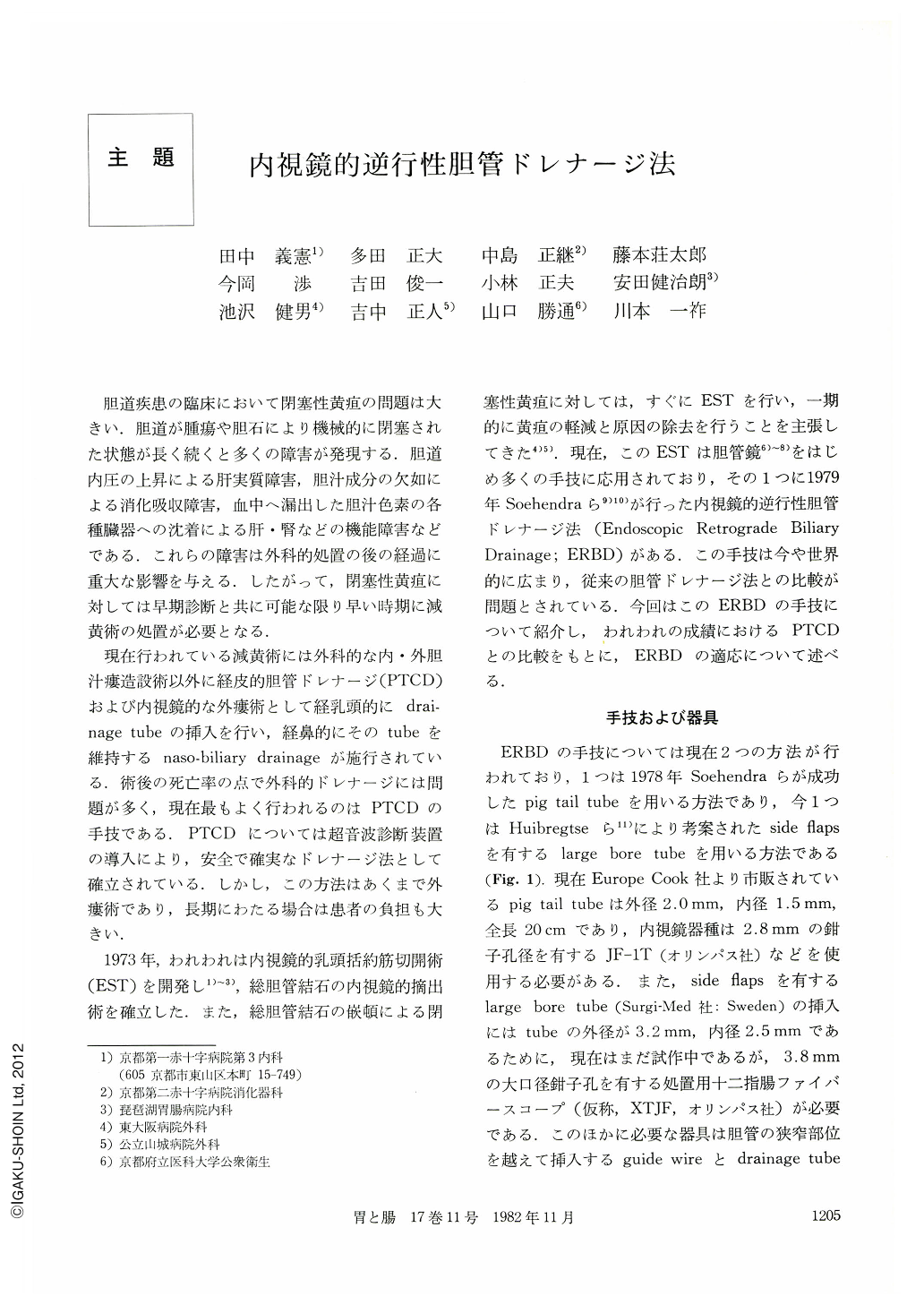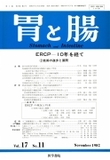Japanese
English
- 有料閲覧
- Abstract 文献概要
- 1ページ目 Look Inside
胆道疾患の臨床において閉塞性黄疸の問題は大きい.胆道が腫瘍や胆石により機械的に閉塞された状態が長く続くと多くの障害が発現する.胆道内圧の上昇による肝実質障害,胆汁成分の欠如による消化吸収障害,血中へ漏出した胆汁色素の各種臓器への沈着による肝・腎などの機能障害などである.これらの障害は外科的処置の後の経過に重大な影響を与える.したがって,閉塞性黄疸に対しては早期診断と共に可能な限り早い時期に減黄術の処置が必要となる.
現在行われている減黄術には外科的な内・外胆汁瘻造設術以外に経皮的胆管ドレナージ(PTCD)および内視鏡的な外瘻術として経乳頭的にdrainage tubeの挿入を行い,経鼻的にそのtubeを維持するnaso-biliary drainageが施行されている.術後の死亡率の点で外科的ドレナージには問題が多く,現在最もよく行われるのはPTCDの手技である.PTCDについては超音波診断装置の導入により,安全で確実なドレナージ法として確立されている.しかし,この方法はあくまで外瘻術であり,長期にわたる場合は患者の負担も大きい.
Between October 1981 and July 1982 the introduction of ERBD tube (18 pig tail catheter and two large bore tube with side flaps) was successful in 20 out of 26 patients (76.9%) with obstructive jaundice, 14 males, 6 females, mean age 62.0 (range 38~76). In 15 patients the biliary obstruction was due to malignancy (6 pancreatic cancers, 6 biliary cancers, 3 metastatic liver tumors) and in 5 patients due to benign disease (2 choledocholithiasis with cholangitis, 2 choledocholithiasis with cholecystolithiasis, 1 benign papillary tumor). In 4 out of 15 patients with malignant disease the surgical operation was performed in four weeks after ERBD and 2 patients died in the first month after the insertion of the endoprosthesis. Nine patients are still living more than one month after ERBD. The average time interval is 11.7 weeks (range 4~28). In 6 secondary ERBD cases the ERBD was performed after the relief of jaundice by PTCD, in 14 primary ERBD cases only the insertion of ERBD tube were performed due to relieve jaundice. Complications were 5 cases, one perforation of duodenal wall with pig tail ERBD tube, one dislodgement and 2 cloggings of drainage tube by blood and bile and one case of cholangitis after the insertion of the endoprosthesis.
On the drainage effect 14 primary ERBD cases were compared with 32 PTCD cases without liver metastasis. No significant difference can be statistically detected in serum bilirubin level before biliary drainage between 11.6±7.8 mg/dl (mean±S) in primary ERBD cases and 16.6±10.6 mg/dl in PTCD cases. The percentage of the cases with under 5 mg/dl in serum bilirubin level two weeks after biliary drainage was 78.6 in primary ERBD and 56.2 in PTCD, no significant difference could be found. On the other hand, the decreasing rates expressed the percentage of the bilirubin level after biliary drainage against the level before drainage were significantly lower in primary ERBD cases than those of PTCD at two weeks (p<0.005) and four weeks (p<0.01) after biliary drainage. It was concluded from these results that ERBD was effective biliary drainage same as PTCD and could be used as a permanent safety drainage.

Copyright © 1982, Igaku-Shoin Ltd. All rights reserved.


